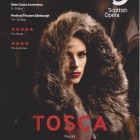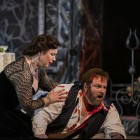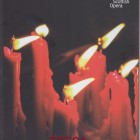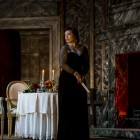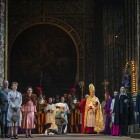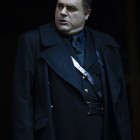Tosca 2019Scottish Opera
Read more about the opera Tosca
When last seen in 2012, this venerable staging was revived, as now, under the direction of Jonathan Cocker. He treated the late Anthony Besch's vision with great respect, while preserving a sense of razor-sharp relevance that defies the production's age. Its return is welcome, with an excellent cast, conducted by Stuart Stratford. It is tempting to suggest that it could host satisfying performances for another forty years, as long as it is as well revived as here.
The three singers in the leading roles are all familiar from their previous work with the company. Natalya Romaniw (Tosca) has appeared here in Rusalka, L'amico Fritz and Eugene Onegin. Gwyn Hughes Jones (Cavaradossi) and Roland Wood (Scarpia) were both in the recent Trovatore revival. The alternate soprano, Sinéad Campbell-Wallace, began the season with an excellent performance as Silvia in an extremely rare verismo piece, Mascagni's Zanetto, and should be well-suited to the title role, which she will sing once in each of the four theatres.
At the third performance, a Sunday matinee in Glasgow, everything went well from the first notes. The sets still looked handsome and were well lit. The allied air-raid as the final curtain falls - an after-thought by Besch for one of his own early revivals (he always liked to revise his stagings if he saw fit) worked well. The fact that company Musical Director Stuart Stratford was in charge ensured there was not the slightest sense of routine creeping in. All the atmospheric touches of orchestration made their full effect and he supported his singers with a lot of flexibility in tempo and phrasing.
The individual performances were highly detailed. Natalya Romaniw made a superb Tosca. Her voice had all the power required, Her phrasing and breath control were near miraculous, not just in 'Vissi d'arte', but throughout. In the second act, her constant prowling round the room like a trapped animal was quite riveting.
Gwyn Hughes Jones has not been seen often in Scotland, and his Cavaradossi has already graced the stages of ENO, WNO and Los Angeles. Like his soprano, the breath control was amazing, allowing a subtlety of musical treatment that is rarely heard in this part. As with his Manrico, he had a fine series of ringing high notes, though it was his soft, legato work that was perhaps even more impressive.
Roland Wood was an effective Scarpia, much helped at his first entry by needing only a couple of strides to reach centre stage from behind that great central pillar that hid his entry to the building. Perhaps he could have projected more sheer evil like some earlier interpreters of the part. But he was a suave villain as he toyed with his victims, and that was an equally valid approach.
The shorter roles were also given fine treatment. Dingle Yandell was a suitably lean and hungry Angelotti. Spoletta (Aled Hall) and Sciarrone (Lancelot Nomura) were well contrasted as Sparpia's two henchmen. Indeed at curtain call Spoletta was also treated to the now traditional pantomime - style combination of boos and cheers usually reserved for the chief villain.
This was an excellent revival of one of the justly most popular operas in the repertoire. There seemed to be plenty of young people buying cheap tickets on the day and perhaps seeing an opera live for the first time. This was just the type of presentation to bring them back in droves.
It was good to be able to return to a further performance at the first night in Edinburgh, a Thursday with a packed out and hugely enthusiastic audience. When a production is as well conceived as this one, and mounted with such care and attention to detail on stage and in the pit, its actual age becomes irrelevant. An unusual amount of rarely-heard instrumental detail emerged from the orchestra. The audience reacted with glee to the comedy of the exchanges between the lovers as she glares at the portrait. Small details in the staging had great impact - the criticism by Scarpia of inappropriate behaviour in church by the choirboys and Tosca contrasting with his own misconduct, only kneeling before Mussolini himself. Many of the audience will have been seeing an opera for the first time, and it is hard to conceive of a better launch vehicle.
There has been an element of good fortune for British opera companies when it comes to presenting the major operas of Puccini. Welsh National Opera launched a memorable staging of Madama Butterfly in the early 1970s, directed by the brilliant Joachim Herz. This production was still in fine fettle when revived a couple of years ago. The Royal Opera at Covent Garden mounted John Copley's staging of La bohème in 1974, itself succeeding the first London staging that had presented the likes of Caruso and Melba. They also had, for some thirty years, a memorable interpretation of Tosca, by Franco Zeffirelli, which was launched in 1964 with Maria Callas as the diva and Tito Gobbi as Scarpia. These London stagings have now been retired. There is another mature production of a non-Puccini work - the joint Scottish/Welsh staging of The Cunning Little Vixen was first seen at the 1980 Edinburgh Festival, and was recently revived in Cardiff to great acclaim.
This means that Scottish Opera's fine Tosca, updated to the Mussolini era, and first seen in October 1980, is now the third most venerable opera production in the country. The unusually lavish sets and costumes were created due to the original run being sponsored by one of those great Scottish business institutions than no longer exist, and whose contributions are so sadly missed. The insurance company Scottish Amicable, with headquarters in Stirling, was an important provider of sponsorship funding for many years. Between 1978 and 1995 they subsidised several productions - a Rossini double bill (The Marriage Contract and The Silken Ladder); The Bartered Bride by Smetana; and a series of four memorable Puccini stagings - Tosca, Manon Lescaut, Madama Butterfly and Turandot.
There are three Dementia Friendly performances - in Glasgow on 24 October, Aberdeen on 1 November and Edinburgh 19 November. All are at 3.00pm.
Scottish Opera's 2019/20 Season
The season opened at the Edinburgh International Festival with the European premiere of Breaking the Waves by Missy Mazzoli. The autumn performances got under way with a visit to the Lammermuir Festival on 20 September with a single performance in concert of an unusual double bill - Mascagni's Zanetto and Wolf-Ferrari's Susanna's Secret. The Glasgow season opens with a welcome revival of Tosca. There is a Sunday afternoon concert of Iris, another rare work by Mascagni. In the New Year there are new productions of Nixon in China by John Adams as well as Britten's Midsummer Night's Dream. and Sullivan's Gondoliers. Further concerts include a pairing of Mascagni's Cavalleria Rusticana with Leoncavallo's Zingari. There are also concert performances of a late Sullivan piece, Utopia, Limited, as well as the usual Opera Highlights tour of the Highlands and Islands.
Performance Cast
- Cesare Angelotti former Consul, now a political prisoner
- Sacristan
- Mario Cavaradossi a painter
- Floria Tosca a famous singer
-
Natalya Romaniw (Exc Oct 18; Nov 2, 7, 21)
Sinéad Campbell-Wallace (Oct 18; Nov 2, 7, 21)
- Baron Scarpia Chief of Police
- Spoletta police agent
- Sciarrone police officer
- Shepherd boy
- Gaoler
Production Cast
Performance DatesTosca 2019
Theatre Royal, Glasgow | Glasgow
16 Oct, 19.15 18 Oct, 19.15 20 Oct, 15.00 22 Oct, 19.15 26 Oct, 19.15
His Majesty's Theatre, Aberdeen | Aberdeen
31 Oct, 19.15 2 Nov, 19.15
Eden Court Theatre | Inverness
5 Nov, 19.15 7 Nov, 19.15 9 Nov, 19.15
Festival Theatre, Edinburgh | Edinburgh
14 Nov, 19.15 17 Nov, 15.00 21 Nov, 19.15 23 Nov, 19.15
